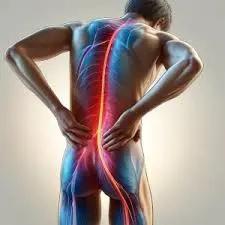Sciatica pain, often described as a sharp, shooting, or burning sensation radiating down the leg, can significantly impact one’s quality of life. Understanding the underlying causes and triggers of this nerve-related pain is important for effective treatment and prevention. Here, we will take a closer look at the various factors that can contribute to sciatic nerve pain, providing you with the knowledge to take proactive steps towards reducing your symptoms.
Anatomy of the sciatic nerve
The sciatic nerve is the longest and thickest nerve in the human body, originating from the lower back (lower lumbar) and extending through the buttocks and legs. It is a bundle of several spinal nerve roots that come together forming a single nerve pathway. This network of nerves transmits sensations and motor functions to the lower body such as the back of the thigh, part of the lower leg, and the sole. Any disruption or irritation to the sciatic nerve can lead to the symptoms associated with sciatica, such as low back pain accompanied by leg pain.
Common causes of sciatica
Herniated discs
One of the most common causes of sciatic nerve pain is a bulging or herniated disk in the spine. This condition occurs when the soft, cushiony material between the vertebrae protrudes or ruptures, putting pressure on the surrounding nerves, including the sciatic nerve. The compression or irritation of the nerve can result in radiating pain, numbness, and tingling sensations down the leg.
Degenerative disc disease
As we age, the intervertebral discs in the spine can gradually degenerate, leading to a condition known as degenerative disc disease. This can cause the discs to lose their height and flexibility, increasing the risk of disc herniation and further sciatic nerve irritation.
Spinal stenosis
Spinal stenosis is a narrowing of the spinal canal, which can put pressure on the nerves, including the sciatic nerve. This condition is often associated with age-related changes in the spine, such as the development of bone spurs or thickening of the ligaments. The compressed nerve can trigger sciatic nerve pain, as well as numbness and weakness in the affected leg.
Piriformis syndrome
The piriformis muscle, located in the buttocks, can sometimes spasm or tighten, compressing the sciatic nerve, leading to sciatic nerve pain. This condition, known as piriformis syndrome, can be the result of overuse, injury, or underlying muscle imbalances.
Pregnancy-related sciatica
Sciatica is relatively common during pregnancy, as the growing fetus can put pressure on the sciatic nerve. The additional weight and changes in the body’s centre of gravity can also contribute to sciatic nerve irritation.
Trauma or injury
Sudden injuries, such as a herniated disc or pelvic fracture, can damage or compress the sciatic nerve, triggering severe sciatic nerve pain. Even minor injuries, like a muscle strain or sprain, can indirectly lead to sciatic nerve irritation through inflammation and muscle spasms.
Tumors or cysts
In rare cases, the presence of tumors, cysts, or other growths in the lower back or pelvic region can put pressure on the sciatic nerve, causing pain and other neurological symptoms.
Risk factors for sciatic nerve pain
While some causes of sciatic nerve pain are unpredictable or unavoidable, several risk factors can increase the likelihood of developing this condition:
- Age: As we get older, the natural wear and tear on the spine can lead to conditions like disc degeneration and spinal stenosis
- Obesity: Carrying excess weight can put additional strain on the spine and increase the risk of disc herniation and other spinal issues
- Sedentary lifestyle: Long periods of sitting or lack of physical activity can weaken the core and back muscles, making the spine more vulnerable to injury and nerve compression
- Occupational factors: Jobs that involve heavy lifting, repetitive bending, or prolonged sitting can put individuals at a higher risk of developing sciatic nerve pain
- Diabetes: Individuals with diabetes have an increased risk of developing peripheral neuropathy, which can contribute to or exacerbate sciatic nerve pain
- Genetics: Some people may be genetically predisposed to certain spinal conditions that can lead to sciatic nerve irritation
Understanding these risk factors can help individuals take proactive steps to minimise their chances of experiencing sciatic nerve pain.
Diagnosis and symptoms of sciatica
The classic symptom of sciatic nerve pain is a sharp, shooting, or burning sensation that radiates from the lower back, through the buttocks, and down the leg, often reaching as far as the foot or toes. Patients may also experience tingling, numbness, or muscle weakness in the affected leg. The severity of the symptoms can vary, with some individuals experiencing mild discomfort, while others may have debilitating pain that interferes with daily activities.
To diagnose sciatic nerve pain, healthcare providers will typically begin with a physical examination, assessing the patient’s range of motion, reflexes, and muscle strength. They may also perform imaging tests such as X-rays, Magnetic Resonance Imaging (MRI) and Computed Tomography (CT) scans.
By combining a physical examination with diagnostic tests, healthcare providers can accurately identify the underlying cause of sciatic nerve pain and develop a treatment plan.
Treatments for sciatic nerve pain
In many cases, sciatic nerve pain can be effectively managed through non-surgical treatments. These aim to reduce inflammation, relieve pain, and promote healing, allowing the body to address the underlying issue. Some common treatment options include:
Medications
Over-the-counter anti-inflammatory medications, such as ibuprofen or naproxen, can help alleviate pain and inflammation. In more severe cases, healthcare providers may prescribe stronger pain relievers, muscle relaxants, antidepressants or anti-seizure medications to target neuropathic pain.
Physical therapy
A comprehensive physical therapy program can be highly beneficial for individuals with sciatic nerve pain. Therapists may recommend a combination of stretching, strengthening exercises, and manual techniques, such as massage or spinal mobilisation, to improve flexibility, increase muscle strength, and reduce nerve irritation.
Spinal injections
In some instances, healthcare providers may recommend epidural steroid injections to the affected area. These injections can help reduce inflammation and provide temporary pain relief, allowing the patient to engage in physical therapy and other rehabilitative activities.
Alternative therapies
Alternative treatments, such as chiropractic adjustments, acupuncture, and massage therapy, have shown promise in managing sciatic nerve pain. These approaches may help reduce symptoms, improve mobility, and reduce the need for medications or more invasive interventions.
Lifestyle modifications
Making changes to one’s daily routine and habits can also play a significant role in managing sciatic nerve pain. This may include maintaining good posture, losing weight and incorporating regular low-impact exercise, such as walking, swimming, or yoga into daily life.
By employing a combination of these treatments, many individuals with sciatic nerve pain can experience substantial relief and improve their overall quality of life.
Surgical interventions for sciatic nerve pain
In cases where treatments fail to provide adequate relief or there is severe pain, healthcare providers may recommend surgical intervention. The primary goal of these procedures is to address the underlying cause of the sciatic nerve irritation and alleviate the associated symptoms. Some common surgical options include:
Discectomy
This procedure involves the removal of a portion of a herniated or bulging disc that is compressing the sciatic nerve. By removing the disc material, the pressure on the nerve is relieved, leading to a reduction in pain and other symptoms.
Laminectomy
A laminectomy involves the removal of a small section of the vertebral bone, known as the lamina, to create more space for the spinal cord and nerves. This can be particularly helpful in cases of spinal stenosis, where the narrowing of the spinal canal is causing sciatic nerve compression.
Spinal fusion
In some cases, healthcare providers may recommend a spinal fusion procedure, which involves fusing two or more vertebrae to provide additional stability and support to the spine. This can be beneficial for individuals with severe degenerative disc disease or spinal instability that is contributing to their sciatic nerve pain.
It’s important to note that surgery should be considered a last resort, as it carries risks. Healthcare providers will carefully weigh the benefits against the risks before recommending a surgical intervention.
Prevention
While some causes of sciatic nerve pain may be unavoidable, there are several steps individuals can take to reduce the risk of experiencing a recurrence or worsening of their symptoms:
- Maintain good posture: Proper alignment of the spine, whether sitting, standing, or sleeping, can help prevent excessive strain and stress on the lower back and sciatic nerve
- Regular exercise: Low-impact activities, such as walking, swimming, or gentle yoga, can help strengthen the core and back muscles, improving spinal stability and reducing the risk of nerve compression
- Losing weight: Carrying excess weight can put additional strain on the spine and increase the likelihood of disc herniation or other spinal issues. Achieving a healthy weight can significantly reduce the risk of sciatic nerve pain
- Proper lifting techniques: When lifting heavy objects, it’s important to use the legs, not the back
- Manage underlying conditions: Addressing and controlling underlying medical conditions, such as diabetes, can help prevent or mitigate the development of peripheral neuropathy, which can contribute to sciatic nerve pain
- Quit smoking: Smoking has been linked to an increased risk of disc degeneration and other spinal problems, which can lead to sciatic nerve irritation
- Stress-reducing techniques: Chronic stress can worsen muscle tension and inflammation, which may worsen sciatic nerve pain. Engaging in stress-management activities, such as meditation, deep breathing, or mindfulness practices, can be beneficial
By adopting these preventive measures, individuals can take an active role in maintaining a healthy spine and reducing the likelihood of experiencing recurrent or persistent sciatic nerve pain.
Conclusion
Sciatic nerve pain can be a debilitating condition that significantly impacts an individual’s quality of life. Understanding the triggers and risk factors associated with this condition is the first step towards effective management and prevention. By exploring the underlying causes, such as herniated discs, spinal stenosis, and piriformis syndrome, and employing a combination of conservative and, if necessary, surgical treatments, individuals can find relief and regain control over their health and well-being. Remember, a proactive approach that includes lifestyle modifications, physical therapy, and timely medical attention can go a long way in managing and preventing the recurrence of sciatic nerve pain.
Sources
- Sciatica: What It Is, Causes, Symptoms, Treatment & Pain Relief
- Sciatica – Diagnosis and treatment – Mayo Clinic
- Sciatica – NHS
Medical Disclaimer
NowPatient has taken all reasonable steps to ensure that all material is factually accurate, complete, and current. However, the knowledge and experience of a qualified healthcare professional should always be sought after instead of using the information on this page. Before taking any drug, you should always speak to your doctor or another qualified healthcare provider.
The information provided here about medications is subject to change and is not meant to include all uses, precautions, warnings, directions, drug interactions, allergic reactions, or negative effects. The absence of warnings or other information for a particular medication does not imply that the medication or medication combination is appropriate for all patients or for all possible purposes.








